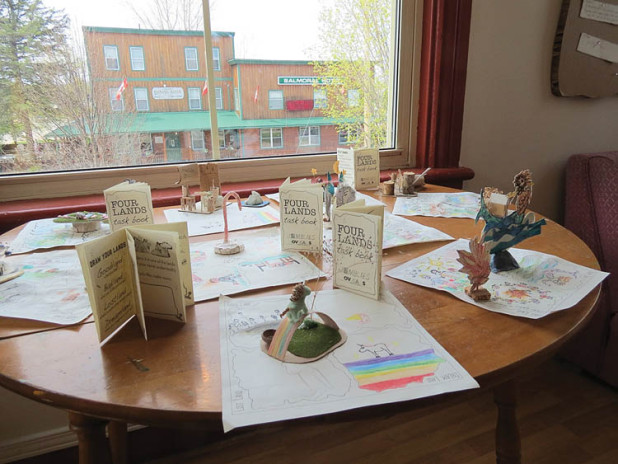General News » News
Four Lands a metaphor of inclusion at South of 60
June 2, 2016

Part of The Four Lands art installation at the Barry’s Bay South of 60 Arts Centre; the exhibit continues through June.
By Sarah Vance
The experience of a land can be as much social and cultural as it is geographical. This theme, as it is woven through time and memory, is the focus of a new installation on the second level of the South of 60 Art Gallery at the railway station in Barry’s Bay.
Four Lands is a community-driven installation representing a collaboration between Toronto-based Jumblies Theatre and Ottawa Valley Creative Arts Open Studio (OV-CAOS). Jumblies Theatre, a Canadian community arts company, is known for projects where the overall concept of social inclusion is explored.
Four Lands is intergenerational in nature, and involves conversations with more than 100 people about their experiences within communities where the soil they call home is shared between cultures.
Cardboard miniature models of everyday events and experiences are in abundance, created by these participants using the themes: “a good land,” “ a bad land,” “a lost land,” and “a dream land.” Each of these themes embodies different values which participants have explored when they gathered together at different sites to create their own versions of what they imagine and wish for – what nourishes them – in contrast to experiences that they don’t like or might dream about changing.
The project has been funded by the Ontario Arts Council, the Trillium Foundation, Canada Council for the Arts, along with Mizewi Biik Aboriginal Employment Agency, in partnership with South of 60 and the mental health team at Algonquin Pikwakanagan First Nation, and other local agencies.
There are threads through these voices and their accompanying cardboard models, restorative in nature and supportive of building resiliency. These threads are embedded in anecdotal statements pinned to the walls of the South of 60, combining anonymous statements like these examples from the “Good Land”: “I can become who I really am”; “I am drinking tea with someone I love”; “We are all connected”; “I can reach for my children.”
These are in contrast to statements coming from the “Dream Land,” where memory and time may have seized these realities or interrupted their fluidity. Models include the gravestones of lost loved ones.
From the “Bad Land” the writing on the wall is much different, expressing a collection of isolated and vulnerable voices: “I feel broken and bleeding”; “My sadness and longing vibrates from me”; “I am afraid to say something.”
In the “Lost land,” speakers identify the dissolution of culture and traditions, where they “only remember.”
These different themes are on display on cardboard canvases that look like different island-pedestals. They occupy the four corners of the upper-floor of the South of 60 Gallery.
Some models include recorded-audio statements from children, which come to life when the cardboard model is picked up.
This deeply personalized and restorative project continues to be on display at the South of 60 Arts Centre into June.

















